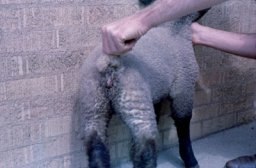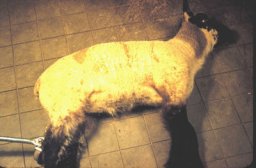Tetanus
Tetanus, also known as lockjaw, is caused by Clostridium tetani. Typically tetanus is seen in lambs (less than six months of age) in the spring following castration and/or docking. Clostridium tetani are gram positive, anaerobic, rod-shaped bacteria that are found in the soil. Bacteria gain access through wounds from foot punctures, needle perforations, shearing, tagging, etc. Clostridium tetani releases two different toxins; tetanolysin, which hemolyzes erythrocytes and tetanospasmin, which attacks the nervous tissue. The majority of the clinical effects of C. tetani are due to the neurological effects of tetanospasmin. Tetanospasmin diffuses in the muscle and neuronal terminals, traveling up the motor axons to the central nervous system. At the spinal cord and medulla, synaptic inhibitions are decreased, resulting in muscles that are continuously contracted until physical exhaustion occurs. Eventually death results from respiratory failure.
Clinical Signs

Clinical signs typically occur four to ten days post injury.
Early stages
- ears erect
- stiff and elevated tail
- head extended
- the eyes appear anxious but cannot move
- prolapsed nictitating membrane
- legs are rigid and extended, making walking difficult
- sudden auditory and tactile stimuli provoke violent muscular contractions
As the disease progresses
- animal is unable to walk and can not rise
- jaw locks
- nostrils dilated
Affected sheep die within three to ten days (mortality rate is 100%). Death results from respiratory failure.
Diagnosis

- history of injury within the last 30 days
- muscular spasticity stimulated by auditory and tactile stimuli
Primary differentials include strychnine poisoning (which usually lasts for only a few hours) and hypomagnesaemia (chemical analysis of blood will include low magnesium).
Prevention
Using clean needles and clean tools for castration, tagging, shearing and docking, can prevent tetanus. Also a vaccination program that includes an eight in one clostridium vaccine can protect against clostridial disease.
Suggested vaccination program for ewes and rams
- give initial vaccination
- schedule secondary vaccination six weeks post-initial vaccination
- give booster two to four weeks before lambing
for lambs to be kept over 16 weeks (for fattening or breeding)
- give initial vaccination at 12 weeks
- secondary vaccination at 18 weeks
- booster for breeding lambs at pre-lambing time, along with adult ewes
(If lambs are out of unvaccinated or inadequately vaccinated ewes, they should be either vaccinated during the first week and given a secondary vaccine at six weeks or be given 100 ml of colostrum from a vaccinated ewe.)
In addition, treatment of animals with puncture wounds should include injection of tetanus antitoxin and antibiotics. The wound should be thoroughly cleaned with water and antibacterial solution. Smaller puncture wounds should be opened and flushed with hydrogen peroxide solution. Animals affected with tetanus should be placed in a dark and quiet area, and be given chlorpromazine daily (total of 100 mg divided up in several doses given over several days.
Reference
Jensen and Swift's Diseases of Sheep. Cleon V. Kimberling. Lea and Febiger, Philadelphia, 1988.
Notes for the Sheep Clinician. M.J. Clarkson, W.B. Faull. Liverpool University Press, 1987.
Prepared by Cleon V. Kimberling and Terri Taraska
Optimal Livestock Services, LLC
970-231-2477
Copyright © 2016 CleonsCorner.com All Rights Reserved
